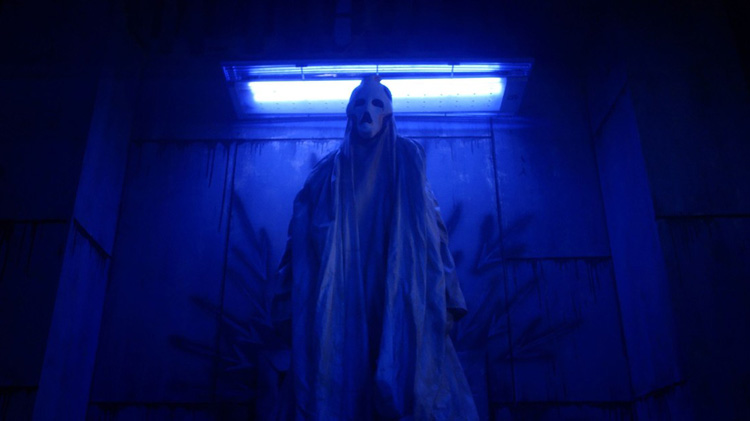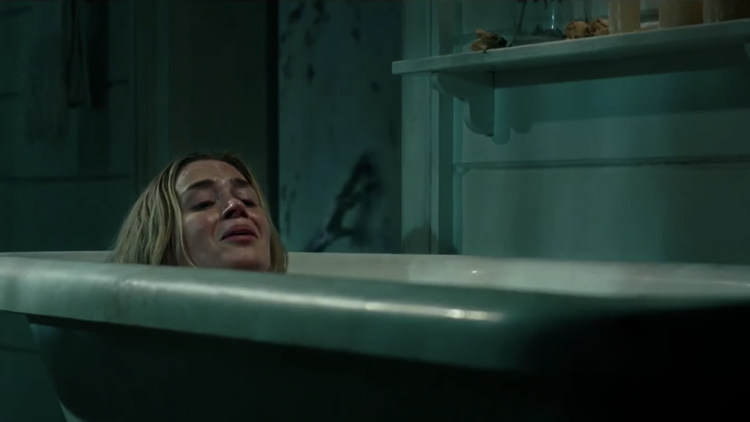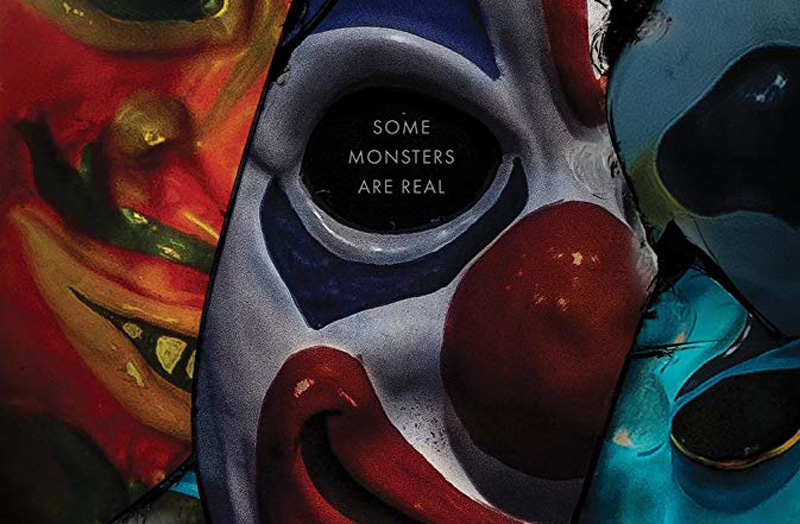Momentum Pictures has provided ComingSoon.net with with the chance to interview A Quiet Place writers Scott Beck and Bryan Woods about their latest horror effort Haunt, produced by Eli Roth. Check out the interview below!
RELATED: Exclusive Haunt Clip For the Horror Film From A Quiet Place Writers
On Halloween, a group of friends encounter an “extreme” haunted house that promises to feed on their darkest fears. The night turns deadly as they come to the horrifying realization that some monsters are real.
Written and directed by Scott Beck and Bryan Woods, co-writers and executive producers of the critically acclaimed A Quiet Place, Haunt stars Katie Stevens (Faking It, The Bold Type), Will Brittain (Kong: Skull Island, Everybody Wants Some!!) and Lauryn Alisa McClain (Descendants: Wicked World, Daddy’s Little Girls).
Haunt can now be seen in theaters, On Demand and on Digital HD.

ComingSoon.net: Obviously, this sort of subgenre of teens coming across some kind of an amusement park or a haunted something or other, you can go all the way back to Tobe Hooper’s “Funhouse”. So for you, what was the spin that you were trying to put on the sub genre?
Bryan Woods: Almost no spin. It’s funny, we wrote “A Quiet Place” and “Haunt” at the same time, and we were kind of making a conscious effort, like while we were writing “A Quiet Place”, we were talking about it as like, a Spielbergian elevated horror genre piece. And at the same time, we’re writing “Haunt”, we’re kind of like, “Fuck that. Horror does not need to be elevated.” Let’s relish and marinate in all of our favorite things about Halloween, the holiday season and horror films in general, and particularly that kind of period of 70s, 80s slashes that you cited, like Tobe Hooper’s “Funhouse”, it’s almost Tobe Hooper’s “The Funhouse”, but the premise that we always wanted that movie to be or thought that movie was until we saw it. Kind of like marinating in just the fun of going into a haunted house with a group of characters and finding out that the people running it are more than they seem. And that was it. We had a lot of fun kind of thematic conversations. But more than anything, we just wanted it to be a rollercoaster ride and we wanted to capture that experience of going into a haunted house and the fun of what that feels like, because Scott and I, as kids growing up in the Midwest, it’s funny. Everyone out here, it’s funny. Everyone out here in California who grew up here, they don’t really know what that is because they have Halloween Horror Nights, which is fun, but that’s kind of like the commercial safe version of it. But in the Midwest, you drive out into the middle of nowhere and you go to a forest and there’s like this abandoned church and these Halloween hobbyists have like, created this haunted house in their dreams. And you go through it and you’re walking through it and you’re just like, wow, this is kind of dangerous. Who are these people that are running this? And where have we found ourselves? And what if something bad happened? Those were kind of all the instincts that we were drawing on from our childhood.
CS: Was there something specific that inspired it?
Scott Beck: To a certain degree, I remember back in the Midwest, it was maybe a half an hour from where we lived, there was a haunted house that was up year round. And it was an incredibly fun attraction to just get everybody in a van and go out there, even if it was the middle of July. And I think everybody, that aspiration of just trying to scare themselves within the confines of something not seemingly safe. And it’s not just exclusive to Halloween. I think it’s exclusive to anybody that wants to get on the fringes of what their fear threshold could potentially be. And so, yeah, I don’t know that I would necessarily classify it as a subculture versus it’s just a fascination with the macabre and the dark side of life. And sometimes, you want that in the middle of April or something when it’s like, Easter. You just want to be scared and find like, these low rent haunted houses in the Midwest that you can still go to outside of the month of October.

CS: There’s a haunted house in Pittsburgh that actually hires a woman who’s like a psychologist as a fear consultant to amp up psychologically all the scares. Did you do any research into the psychology of a haunted house and the things that trigger people and that sort of thing?
Beck: I think like, to a certain degree, what we kind of leaned into was just that audience members, of fans of the genre that go to these movies on Friday and Saturday nights in a packed house. We usually like watching horror films twice, first, just to experience it, and then the second time, to really gauge how the audience is reacting to it from a filmmaking perspective. And so, while it wasn’t necessarily with the psychologist, it very much was studying the psychology of horror movies themselves, and very much in crafting some of the sequences, we would have some sort of gauge of like, where the conventional scare would happen. And then the directors were like, let’s take it one step further beyond the expectation and let’s take one step even beyond that so that hopefully the audience is getting into the suspense of the film, versus just the typical jump scares that you might encounter otherwise in films like this.
Woods: There’s a point in the movie where the suspense starts to crescendo with the ghost character and one of our leads, Nathan, in a hallway. And nine out of 10 movies like, that’s where the killer comes out and makes the kill. And we wanted to kind of do the opposite. We wanted to have the killer turn the lights on and say, “Everything’s fine. How can I help you?” He looks distressed, like what can we do? And just, it’s fun for us to kind of zig-zag and go left, when we should be going right. And but that’s kind of more the conversations we’re having as we’re writing.
CS: Right, zig when you should zag, that kind of thing. I talked to your producer last year, Eli Roth, and he made a really interesting point: He said no horror film is ever going to be as scary as the first time you see it. And as the guys who have seen this movie probably more than anybody else, even though you conceived it, even though you’ve watched it a million times in the editing room, are there scenes that still kind of dig into you?
Woods: (Laughs) Yes, but not the way you mean, like more as from a creative standpoint, we’re always like, oh, that could’ve been better, why didn’t get that. Why is the light not hitting the thing? Like the stupid filmmaker things. I mean, we’re not unnerved by our work ever, but we are while we’re writing it. Like it’s fun to like, be like immersed in your imagination and like, when we were writing “A Quiet Place”, we wrote that movie to this 40-minute loop of wind and wind sounds that we created, writing the movie and imagining being in this world. Like, you can definitely scare yourself at that stage for sure. Once you get to the movie part of the process and you’re seeing it all come together, where it’s “A Quiet Place” or “Haunt”, you only see it with jaded eyes. You’re just literally watching how can we—your job, even as the screenwriters watching rough cuts, your job is like, how can we make this better? How can we make this better? What can we do? Because it’s just all hands on deck and you’re just trying to get to the best product possible before it drops.

CS: There’s a weird theory I have. It’s not based on any research whatsoever, just kind of a gut instinct, but when I saw “A Quiet Place” for the first time, and it got to the whole thing about how they’re going to have this baby within this horrifying environment. I feel like part of the success of the film comes from appealing to the religious right in, like, middle America, who would watch it and be like, “Yes. Even in the worst circumstances, do not get rid of the baby!” I’m wondering if you think there’s any validity to that being the appeal to a lot of the audience that came to it?
Beck: (laughs) I mean, yeah. To a certain degree. I mean, the long story short version of the baby is the original intent of it was that they actually had the baby before the invasion happened, or rather, they got pregnant and now they’re stuck with this option of having the baby or not. The subsequent drafts kind of changed so that it presented it as the baby was conceived after the invasion. But I think the game of it is really going back to the idea of trying to restart your life in the wake of a loss. And in their instance, they lost one of their children. And are they going to be the type of post apocalyptic survivors that start dwelling on the madness and they come to their own destruction? Or are they the ones to have the wherewithal to find a new hope and a new way to move forward? And that’s really what we were trying to champion at the summation of the film.
Woods: I have to say, though, this theory is compelling. You’ve got me thinking about it because we always thought that “A Quiet Place” would be much bigger overseas than in America because we were essentially doing a modern day silent film. Part of the concept was it could travel the world and it’s written in a universal language of cinema, and so, there’s no language barrier. So we thought for sure it would be bigger overseas. But perhaps America is kind of like diehard, like, “We’ll have the baby no matter what.” Maybe in a way that made it pop here slightly bigger than overseas. That’s hilarious.
CS: I really enjoyed your guys’ interview with Mick Garris on his podcast. And during the interview, you talked about how “A Quiet Place” was partly influenced by the films of Jacques Tati, and the way he did a lot of stuff without dialogue. I’m wondering, do you have any interesting non-horror inspirations for “Haunt”?
Woods: Yeah, a couple. One filmmaker that we talked a lot about was Richard Linklater and how his casting of actors is so normal. They feel like real people. In fact, Will Brittain, who plays Nathan, we found him because of our love for “Everybody Wants Some”. The whole cast of “Everybody Wants Some” is like through the roof brilliant. So we were basically like, we’ll take anyone. How many people can we get from that movie? But Will was so brilliant in that film. And so, he’s just a regular guy and the unique kind of improv adlibs that he does that we really embraced. So we talked about that both in terms of casting and also in terms of writing the scripts. The initial cut of the film had way more characters. We truly went all in on like, we’re just going to marinate with the characters and you’re going to think you’re in a Richard Linklater film. And eventually, we kind of scaled that back and made it a little tighter and a little bit more of the rollercoaster ride that it was always meant to be. But Linklater was someone we talked about. We talked a lot about David Fincher’s “The Game” and how that film kind of plays with perception of is it real, is it not real.
Beck: And “Green Room” as well, that came out a couple of years ago.
CS: I love “Green Room”.
Beck: It’s a movie that, you know, especially it feels like a b movie in the best way possible and it’s just like a survival tale about being trapped in a place with these crazy, crazy villains. So all of those combined have inspired us throughout the whole process.










